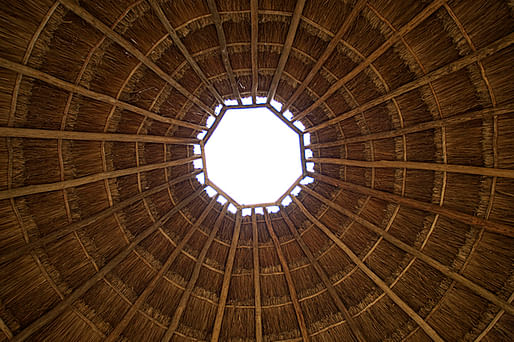
The exhibition Sitio is an intervention of the artist Santiago Borja designed for the Savoye Villachef-d’œuvre of Le Corbusier - based on the statute of icon out of the time and deterritorialized ofthe Villa. It appears a such floating object in space and time, fighting against the possibility ofconstituting only one remarkable enclosure but vacuum; a ’’machine à habiter’’ on diverted. TheSpanish term Sitio - which means ''site' '- insists on the concept of place in the anthropologicalmeaning : a place symbolically given. It also implies, as Roland Barthes defines it in Le Neutre(1978), an ideal place, a place of foundation or an esoteric place where we feel good. In thisdirection, Sitio proposes a multiple reading of the various cultural phenomena which developedaround the Villa, a such kind of plea for what one could name ’’anachronistic contemporaneity’’.

While being based on the thesis that Adolf Max Vogt develops in Le Corbusier le bon sauvage(2003), explaining why Le Corbusier was certainly influenced by lake constructions of frames onsplits discovered in Switzerland during his childhood, Sitio joins together within the same place - theSavoye Villa in Poissy (France) - the modernistic architecture of the Villa and the works created bythe Mexican artist Santiago Borja starting from traditional artisanal techniques of the Indiancommunity Maya. Three works are presented : Destinerrance, Tapis and Cosmogonie suspendue.

Destinerrance, installed in the park, is made up of a superimposing of two ’’palapas’’- small habitator traditional refuge Maya worked out starting from wood and sheets of palm trees of Chiit ofYucatán (Mexico). It testifies to Mexican ancestral architecture while evoking, by its shape ofclepsyder bored in her center, the Hadrian’s Pantheon in Roma, one of the favorite buildings for LeCorbusier as for Santiago Borja. The title of this work is borrowed from the vocabulary of thephilosopher Jacques Derrida, this concept which connects the two apparently antagonistic conceptsof ''destiny' 'and ''errance' ', evokes the complexity and the ambiguity of our connexion with timeand space. The double ''palapa' ' translates this coexistence of opposites through thesuperimposing of two identical structures of which one is reversed, while establishing a link withprimitivism, thanks to the parallel between the splits of the Villa Savoye and the posts of ''thepalapa' '. Destinerrance is made up of imported traditional vegetable materials of Mexico, itsconstruction was entrusted to Mayas manufacturers controlling the ancestral techniques, ''the palaperos' ', who worked during 3 weeks in the park of the Villa to build it.
Tapis, a carpet conceived according to the traditional techniques, colours and Indian fabrics, is spread on the ground of the Villa’s living room. Cosmogonie suspendue, a weaving manufactured according to the techniques and Mayas materials, fixed above the Villa’s terrace, reveals the representation of the cosmos of this Indian community. These two works illustrate the conception of the weaving as the original architecture’s form and as the first cultural element modelling the ’’habitat’’.
No Comments
Block this user
Are you sure you want to block this user and hide all related comments throughout the site?
Archinect
This is your first comment on Archinect. Your comment will be visible once approved.